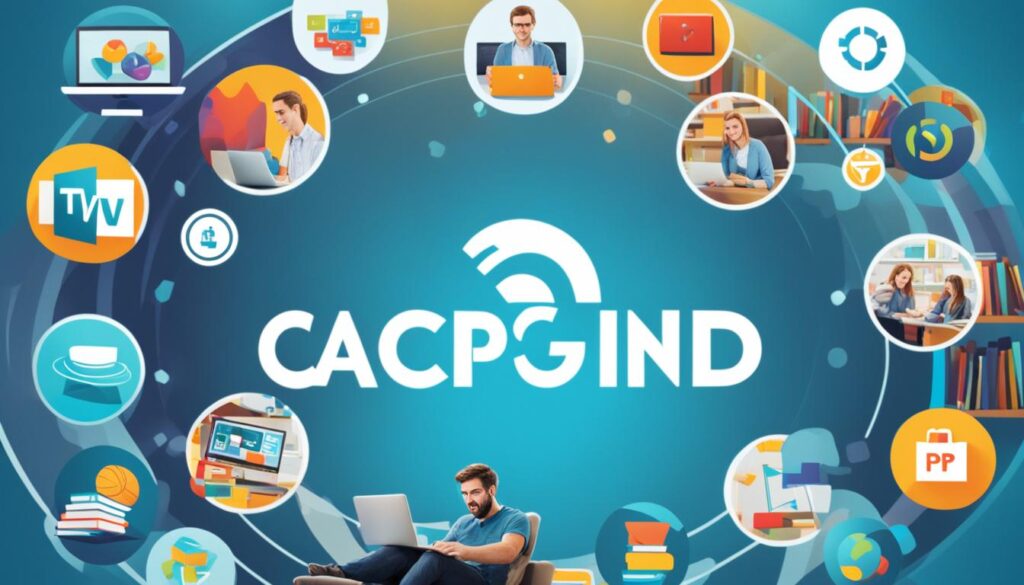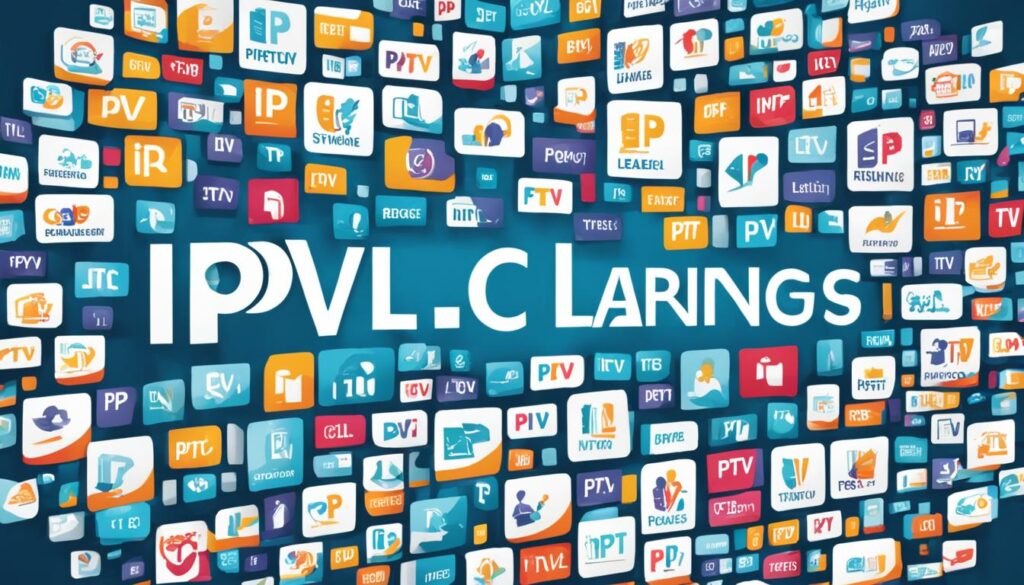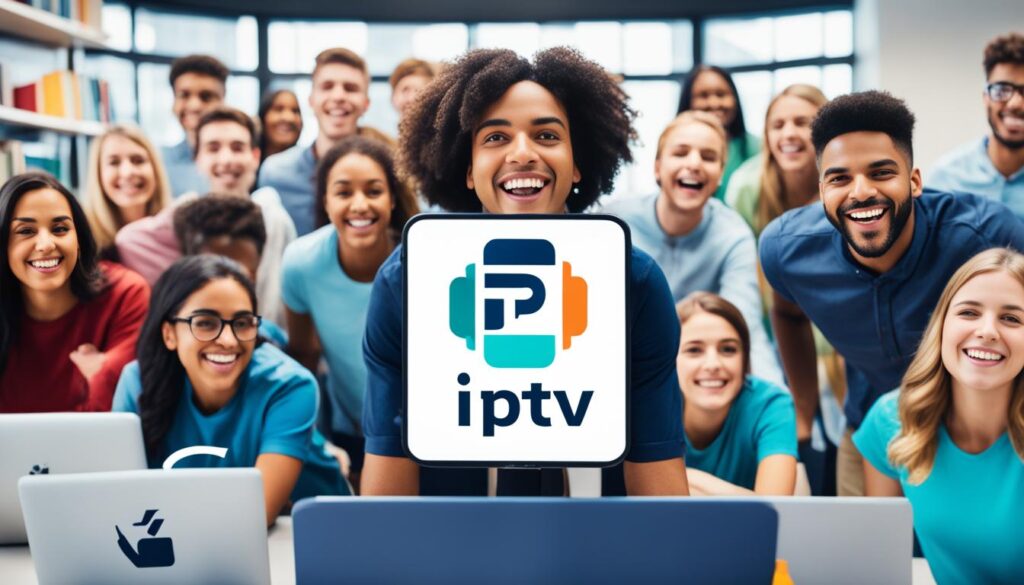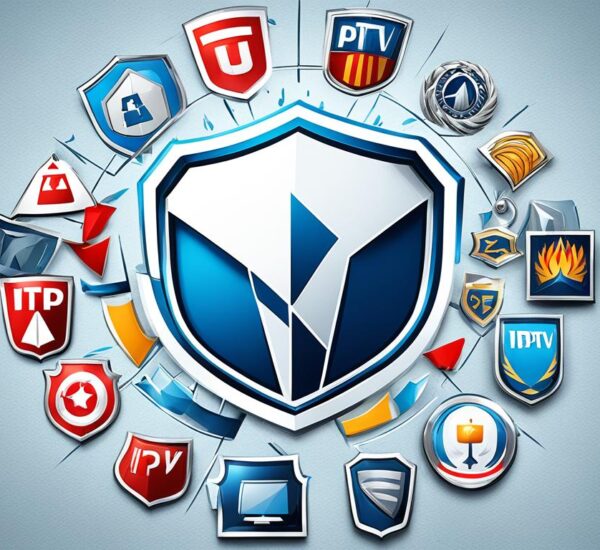Did you know that remote learning has become a vital part of education, with over 1.2 billion students worldwide affected by school closures during the COVID-19 pandemic? This unprecedented shift to online education has highlighted the need for innovative solutions to ensure quality learning experiences for students of all ages.
In this article, we will explore how IPTV (Internet Protocol Television) technology can revolutionize remote learning, bridging the gap between educators and students through high-quality video lectures, virtual classrooms, and on-demand educational resources. From creating engaging virtual classrooms to facilitating seamless communication and collaboration, IPTV offers a range of benefits that enhance the overall remote learning experience.
Key Takeaways:
- Remote learning has affected over 1.2 billion students worldwide.
- IPTV technology can revolutionize remote learning by providing access to high-quality content.
- Virtual classrooms and on-demand access to educational resources enhance engagement and collaboration.
- IPTV offers flexibility and convenience, allowing for self-paced learning.
- Seamless communication and collaboration are enabled through IPTV’s integrated features.
The Benefits of IPTV in Remote Learning
When it comes to remote learning, IPTV technology offers a multitude of benefits that enhance the educational experience for both educators and students. From virtual classrooms to on-demand access to educational resources, IPTV revolutionizes the way education is delivered.
Immersive Virtual Classrooms
IPTV creates immersive virtual classrooms that bring the learning environment to life. With high-quality video lectures and interactive features, students can engage with the content as if they were in a physical classroom. This immersive experience enhances learning retention and student engagement, making remote learning a more dynamic and enjoyable experience.
Flexibility and Convenience
One of the key advantages of IPTV in remote learning is its flexibility and convenience. Students can access educational content anytime, anywhere, allowing for self-paced learning and personalized study schedules. Whether it’s reviewing lectures or accessing supplementary materials, IPTV provides on-demand access to educational resources, ensuring that students can learn at their own pace.
Communication and Collaboration
IPTV facilitates seamless communication and collaboration between educators and students. Integrated chat features and virtual classrooms allow for real-time interaction and discussion, promoting active participation and fostering a sense of community among remote learners. Through this enhanced communication and collaboration, students can engage with their peers and teachers, enabling a more enriching and interactive learning experience.

In conclusion, IPTV technology offers numerous benefits that transform remote learning. From immersive virtual classrooms to on-demand access to educational resources, IPTV enhances flexibility, communication, and collaboration in the remote learning environment. Embracing IPTV opens up new possibilities for effective and engaging remote education.
Creating Engaging Virtual Classrooms with IPTV

IPTV platforms offer educators the opportunity to create engaging virtual classrooms, bringing the benefits of remote learning to life. With IPTV, educators can conduct live lectures, interactive discussions, and collaborative activities in real-time, fostering engagement and participation among students.
In virtual classrooms powered by IPTV, students can actively participate in interactive discussions, ask questions, and share ideas, transcending the limitations of traditional classrooms. This dynamic learning environment encourages collaboration and facilitates peer-to-peer interactions.
Through IPTV, educators can leverage various multimedia resources including high-quality videos, images, and presentations to enhance the learning experience. These resources help to capture students’ attention, making the lessons more memorable and impactful.
With the ability to conduct live lectures, educators can deliver content in real-time, allowing for immediate feedback and clarifications. This creates a sense of connection between educators and students, promoting a more engaging and personalized learning experience.
Interactive Discussions
Interactive discussions play a vital role in virtual classrooms powered by IPTV. Students can actively participate in discussions, share their thoughts, and engage with their peers. This fosters critical thinking, problem-solving skills, and promotes deeper understanding of the subject matter.
Through live chat features, students can communicate with their peers and educators, ask questions, and seek clarification, creating a collaborative and supportive learning environment. These interactive discussions encourage active engagement and help students to connect with the material on a deeper level.
Collaborative Activities
Collaborative activities are another key aspect of engaging virtual classrooms with IPTV. Students can participate in group projects, work on assignments together, and actively contribute to the learning process. This fosters teamwork, communication skills, and cultivates a sense of community among students.
By leveraging various collaborative tools and features, educators can design activities that require students to work together, share ideas, and solve problems collectively. These activities promote critical thinking, creative problem-solving, and enhance the overall learning experience.
Overall, IPTV enables educators to create engaging virtual classrooms by facilitating interactive discussions and collaborative activities. This immersive and dynamic learning environment promotes engagement and participation among students, transforming the way education is delivered and experienced.
Flexibility and Convenience for Remote Learning
When it comes to remote learning, flexibility and convenience play a crucial role in ensuring an effective and enjoyable educational experience. IPTV technology offers a wide range of benefits that cater to the diverse needs of students and educators alike.
On-Demand Access to Educational Resources
IPTV provides students with on-demand access to a wealth of educational resources. Whether it’s reviewing lectures, accessing supplementary materials, or diving deeper into specific topics, students can explore learning materials at their own pace and convenience. This flexibility empowers students to take control of their education, fostering a personalized and self-paced learning experience.
Personalization According to Individual Needs
With IPTV, remote learners have the freedom to personalize their educational journey according to their specific needs and preferences. Whether it’s setting their own study schedule, revisiting difficult concepts, or exploring additional resources, IPTV puts the power of learning in the hands of the students.
Convenience for Busy Lifestyles
For individuals with busy lifestyles, such as working professionals or parents, remote learning through IPTV offers the flexibility to balance their educational pursuits with other commitments. They can access educational content at their convenience, fitting it into their own schedule. This flexibility eliminates the constraints of traditional classroom settings and allows learners to embrace education on their terms.
By combining the convenience of on-demand access with the flexibility to personalize learning, IPTV technology truly revolutionizes the remote learning experience. Students can engage with educational resources in a way that best suits their individual learning style, enhancing both comprehension and retention. With IPTV, remote learning becomes an immersive and empowering journey towards knowledge and self-development.

In the next section, we will explore how seamless communication and collaboration are facilitated through IPTV technology, fostering a dynamic and interactive learning ecosystem.
Seamless Communication and Collaboration with IPTV
In today’s remote learning environment, effective communication and collaboration are essential for creating engaging and interactive educational experiences. IPTV technology offers a seamless solution that enables educators and students to connect, collaborate, and learn together, regardless of physical distance. With integrated chat features, discussion forums, and virtual office hours, IPTV fosters personalized support and creates a dynamic learning ecosystem.
One of the key advantages of IPTV technology is its ability to facilitate real-time communication between educators and students. Through chat features embedded within the IPTV platform, students can ask questions, seek clarification, and engage in discussions with their peers and teachers. This interactive and immediate mode of communication enhances student engagement, encourages active participation, and promotes a collaborative learning environment.
IPTV also facilitates asynchronous communication, allowing students to access discussion forums and engage in conversations at their convenience. This flexibility empowers students to connect with their peers, exchange ideas, and learn from different perspectives. Such collaborative discussions not only foster critical thinking and problem-solving skills but also cultivate a sense of community and belonging in the remote learning space.
Furthermore, IPTV technology enables educators to hold virtual office hours, providing students with dedicated time slots for one-on-one consultations, guidance, and support. Whether through video conferencing or chat-based interactions, virtual office hours bridge the gap between students and educators, ensuring personalized attention and tailored assistance. This direct line of communication plays a crucial role in fostering an inclusive and supportive remote learning environment.
Benefits of Seamless Communication and Collaboration with IPTV:
- Enhanced engagement: Students actively participate in discussions, engage in collaborative projects, and contribute to a vibrant remote learning community.
- Effective information exchange: Real-time chat features and discussion forums enable efficient exchange of ideas, knowledge, and feedback between educators and students.
- Personalized support: Virtual office hours provide dedicated time for individualized guidance, clarifications, and support, ensuring students’ unique needs are met.
- Improved learning outcomes: Seamless communication and collaboration foster deeper understanding, critical thinking, and problem-solving skills.
By embracing IPTV technology, educational institutions can leverage its communication and collaboration features to create an engaging and interactive remote learning experience. Through integrated chat features, discussion forums, and virtual office hours, IPTV facilitates meaningful connections, fosters collaboration, and empowers students to reach their full potential.

| Key Features of IPTV for Communication and Collaboration in Remote Learning | Benefits |
|---|---|
| Integrated chat features and discussion forums | Encourages student engagement and active participation |
| Virtual office hours | Enables personalized support and one-on-one consultations |
| Real-time communication | Promotes immediate interaction and fosters collaborative discussions |
| Asynchronous communication | Allows flexibility for students to engage in discussions at their convenience |
IPTV’s Potential to Democratize Access to Education
Access to quality education is a fundamental right that should be available to all, regardless of their geographical location or socio-economic background. In remote areas where traditional educational infrastructure is limited, IPTV technology emerges as a powerful tool to bridge this gap and democratize access to education.
IPTV, or Internet Protocol Television, has the capability to deliver educational content directly to students’ homes through affordable and accessible devices. It harnesses the power of the internet to provide a wide range of educational resources, including video lectures, virtual classrooms, and on-demand educational materials.
By leveraging IPTV, students in remote areas can gain access to the same high-quality educational content as their counterparts in more developed regions. This technology eliminates the need for physical proximity to educational institutions and enables students to learn from experienced educators and experts, regardless of their location.

IPTV not only ensures access to education but also promotes affordability. Traditional education often entails significant costs, including tuition fees, transportation expenses, and accommodation fees. IPTV technology reduces these financial burdens by eliminating the need for physical attendance and associated costs. Students can access educational content at a fraction of the cost, granting them the opportunity to pursue their academic goals without straining their finances.
Furthermore, IPTV enhances accessibility by catering to diverse learning needs and preferences. The flexibility of IPTV platforms allows students to engage in self-paced learning, where they can access lectures and study materials at their own convenience. This accessibility empowers students to take control of their learning journey and adapt it to their individual schedules and learning styles.
In conclusion, IPTV technology holds immense potential in democratizing access to education. By delivering educational content directly to the homes of students in remote areas, at an affordable cost and with flexible accessibility, IPTV truly revolutionizes the way education is delivered and accessed. It opens doors to a world of knowledge and opportunities for individuals who would otherwise be limited by their geographical location or financial constraints.
Enhancing Engagement and Collaboration through IPTV
IPTV, or Internet Protocol Television, offers a range of features that enhance engagement and collaboration in remote learning environments. By leveraging live streaming, interactive quizzes, and virtual classrooms, educators can create dynamic and interactive learning experiences for their students, resulting in improved learning outcomes.
Live Streaming
One of the key features of IPTV is live streaming. This allows educators to deliver real-time lectures and presentations to their remote students. Through live streaming, students can actively participate in the learning process by asking questions, sharing their thoughts, and engaging in discussions. This real-time interaction creates an immersive learning environment that fosters engagement and active participation.
Interactive Quizzes
Interactive quizzes are another effective way to enhance engagement and collaboration through IPTV. Educators can create interactive quizzes that test students’ understanding of the material and provide immediate feedback. This not only helps students gauge their progress but also encourages collaboration as they can discuss the questions and answers with their peers. The gamified nature of interactive quizzes adds an element of fun and excitement to the learning process, motivating students to actively participate and engage with the content.
Virtual Classrooms
Virtual classrooms provided by IPTV platforms offer a space for students to collaborate, discuss ideas, and work on group projects. These virtual classrooms simulate the interactive nature of traditional face-to-face classrooms, allowing students to interact with their peers and the instructor. Students can collaborate on assignments, participate in group discussions, and exchange ideas in real-time, regardless of their physical location. This level of collaboration promotes a sense of community and teamwork, enhancing the overall learning experience.
Through the combination of live streaming, interactive quizzes, and virtual classrooms, IPTV serves as a powerful tool for enhancing engagement and collaboration in remote learning environments. It enables educators to create dynamic and interactive learning experiences that foster active participation and collaboration among students. By leveraging these features, educators can ensure that students remain engaged, motivated, and connected throughout their learning journey.
Exploring the Diverse Applications of IPTV in Education
In addition to its role in entertainment, IPTV technology has found valuable applications in the field of education. By harnessing the power of IPTV, educators can leverage a wide range of features and content to enhance the learning experience. Let’s delve into the diverse applications of IPTV in education:
Live Lectures
IPTV enables educators to conduct live lectures, providing students with a dynamic and engaging learning environment. Whether it’s a real-time lecture from a renowned expert or a virtual classroom connecting students from different locations, IPTV empowers educators to deliver impactful lessons.
Educational Documentaries
IPTV platforms offer a vast library of educational documentaries, allowing students to explore various subjects in a visual and immersive manner. These documentaries provide valuable insights and in-depth knowledge, enriching the educational journey.
Interactive Tutorials
With IPTV, interactive tutorials can be created to enhance student understanding and engagement. These tutorials can incorporate multimedia elements, quizzes, and interactive exercises, making learning a truly interactive and personalized experience.
Virtual Field Trips
IPTV opens up opportunities for virtual field trips, taking students on immersive journeys to historical sites, natural wonders, and cultural landmarks. Through virtual reality experiences, students can explore the world from the comfort of their classrooms, enriching their understanding of different cultures, environments, and historical events.
As IPTV continues to evolve, its applications in education will continue to grow, revolutionizing the way we teach and learn. By leveraging IPTV technology, educators can create a more engaging and immersive learning experience for students, fostering creativity, critical thinking, and a love for learning.
| Benefits | Explanation |
|---|---|
| Enhanced Engagement | IPTV’s interactive features and immersive content capture students’ attention, leading to increased engagement and participation in the learning process. |
| Accessible Learning | Through IPTV, educational resources become readily accessible, enabling students to learn at their own pace and revisit materials as needed. |
| Expanded Knowledge | With IPTV’s broad range of content, students can explore new subjects, gain a deeper understanding, and broaden their knowledge beyond the traditional curriculum. |
| Virtual Collaboration | IPTV facilitates virtual collaboration, enabling students and educators to collaborate on projects, discuss ideas, and exchange insights, regardless of their physical locations. |
The Role of IPTV in Reducing Costs in Education
As educational institutions adapt to remote learning, finding cost-effective solutions becomes crucial. IPTV technology emerges as a game-changer, offering a centralized platform that reduces costs associated with traditional methods of education delivery.
By leveraging IPTV, educational content can be delivered seamlessly through digital channels, eliminating the need for physical textbooks. Not only does this reduce the expenses associated with printing and distributing textbooks, but it also provides students with instant access to a vast array of educational materials.
Moreover, IPTV enables remote learning, eliminating the need for dedicated classroom spaces. This not only reduces facilities costs for educational institutions but also provides a flexible learning environment for students. With the ability to access educational content remotely, students can learn at their own pace and convenience.
One of the key advantages of IPTV is the potential for significant cost reduction in the long run. By shifting to digital resources, educational institutions can minimize ongoing expenses related to textbook updates and replacements. With IPTV, educational content can be easily updated and distributed, ensuring students have access to the latest information and materials.
Through IPTV technology, educational institutions can streamline their operations and reduce costs, creating a more sustainable and efficient learning ecosystem. By embracing remote learning and leveraging IPTV’s capabilities, educators can focus on providing high-quality educational experiences while maximizing cost reduction opportunities.
Expanding Access to Educational Resources with IPTV
IPTV (Internet Protocol Television) is revolutionizing education by providing students with a wealth of educational resources at their fingertips. Through IPTV, students can access a wide range of multimedia materials, including videos, documentaries, and interactive content, enhancing their learning experience and ensuring a well-rounded education.
By incorporating IPTV into the remote learning environment, educators can supplement traditional instructional methods with engaging multimedia materials. This allows students to explore concepts visually, making learning more dynamic and immersive. IPTV opens up a world of possibilities, expanding access to educational resources that may otherwise be limited by physical resources or geographic location.
With IPTV, students have the flexibility to access educational resources whenever and wherever they need them. Whether it’s reviewing a lecture, watching a documentary, or participating in interactive activities, IPTV empowers students to take control of their learning journey.
IPTV also plays a crucial role in providing a well-rounded education. By offering access to a diverse range of multimedia materials, students can explore different subject areas, develop critical thinking skills, and gain a broader understanding of the world. Whether it’s delving into history through documentaries or studying scientific experiments through videos, IPTV broadens students’ horizons and fosters a love for learning.
To illustrate the impact of IPTV in expanding access to educational resources, let’s take a look at the table below:
| Benefits of IPTV in Education | Traditional Instruction | IPTV Integration |
|---|---|---|
| Access to multimedia materials | Limited by physical resources | Unlimited access to educational videos, documentaries, and interactive content |
| Flexibility in learning | Rigid schedules and limited resources | 24/7 access to educational resources, personalized learning experiences |
| Well-rounded education | Reliance on textbooks and limited exposure | Diverse range of multimedia materials, exploration of different subject areas |
As depicted in the table above, IPTV integration in education offers numerous benefits that traditional instruction alone cannot provide. Through access to multimedia materials, flexibility in learning, and the ability to provide a well-rounded education, IPTV enhances the educational experience and prepares students for success in the digital age.
Conclusion
IPTV technology is revolutionizing the future of education, particularly in the realm of remote learning. By harnessing the power of transformative technology, IPTV enhances the learning experience for students and educators alike. Through its ability to deliver engaging content, foster collaboration, and expand access to educational resources, IPTV is shaping the way we teach and learn.
With IPTV, remote learning becomes an immersive and interactive experience. Students can access high-quality video lectures, participate in virtual classrooms, and explore on-demand educational resources. This flexibility and convenience empower learners to personalize their educational journey and engage in self-paced learning.
Furthermore, IPTV facilitates seamless communication and collaboration between educators and students. Integrated chat features and virtual office hours foster personalized support and create a dynamic learning ecosystem. IPTV also has the potential to democratize access to education by delivering educational content directly to remote areas, making quality education more affordable and accessible.
Embrace the future of education with IPTV and unlock the transformative power of remote learning. As technology continues to advance, it is essential that we leverage innovative tools like IPTV to create an engaging, inclusive, and well-rounded education for all.
FAQ
How does IPTV enhance remote learning?
What are the benefits of IPTV in remote learning?
How does IPTV enable the creation of engaging virtual classrooms?
What is the flexibility and convenience provided by IPTV for remote learning?
How does IPTV facilitate seamless communication and collaboration in remote learning?
How can IPTV democratize access to education in remote areas?
How does IPTV enhance engagement and collaboration in remote learning?
What are the diverse applications of IPTV in education?
What is the role of IPTV in reducing costs in education?
How does IPTV expand access to educational resources?
What is the future of education with remote learning: IPTV?






